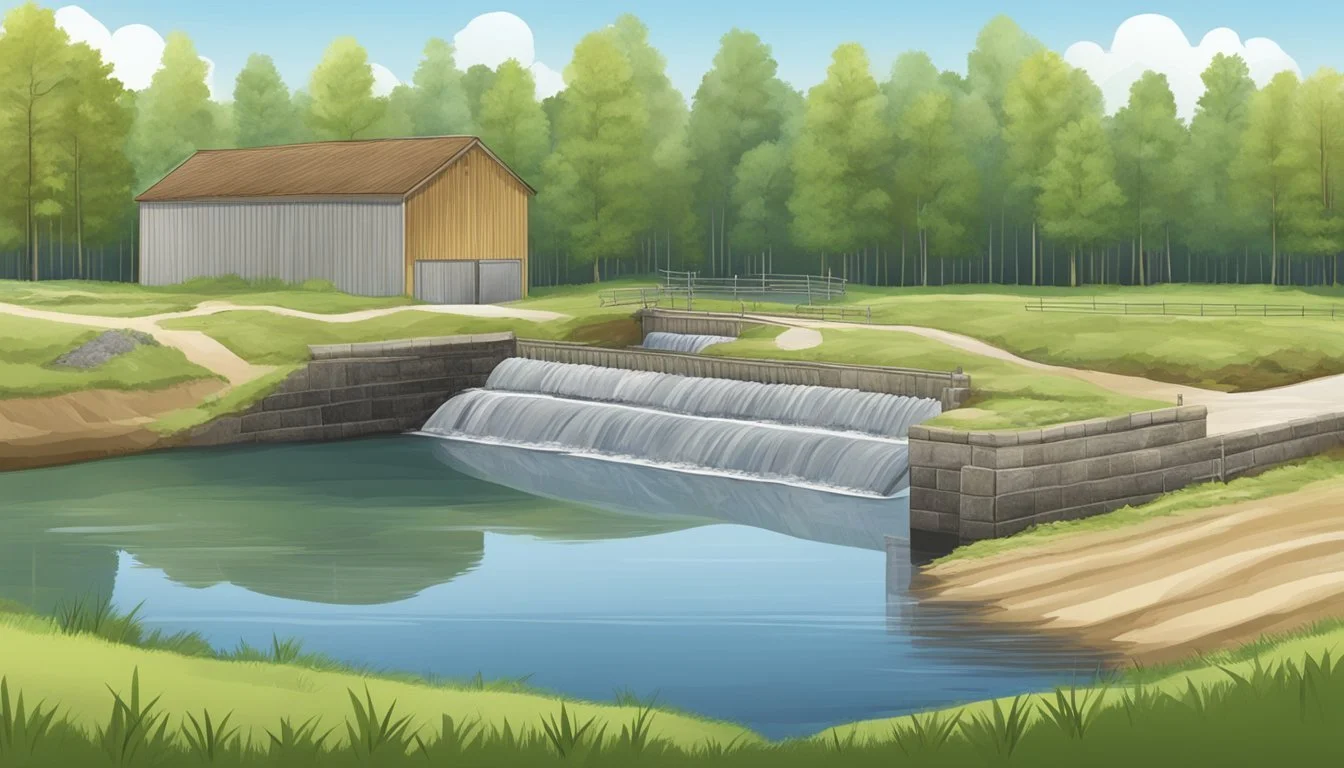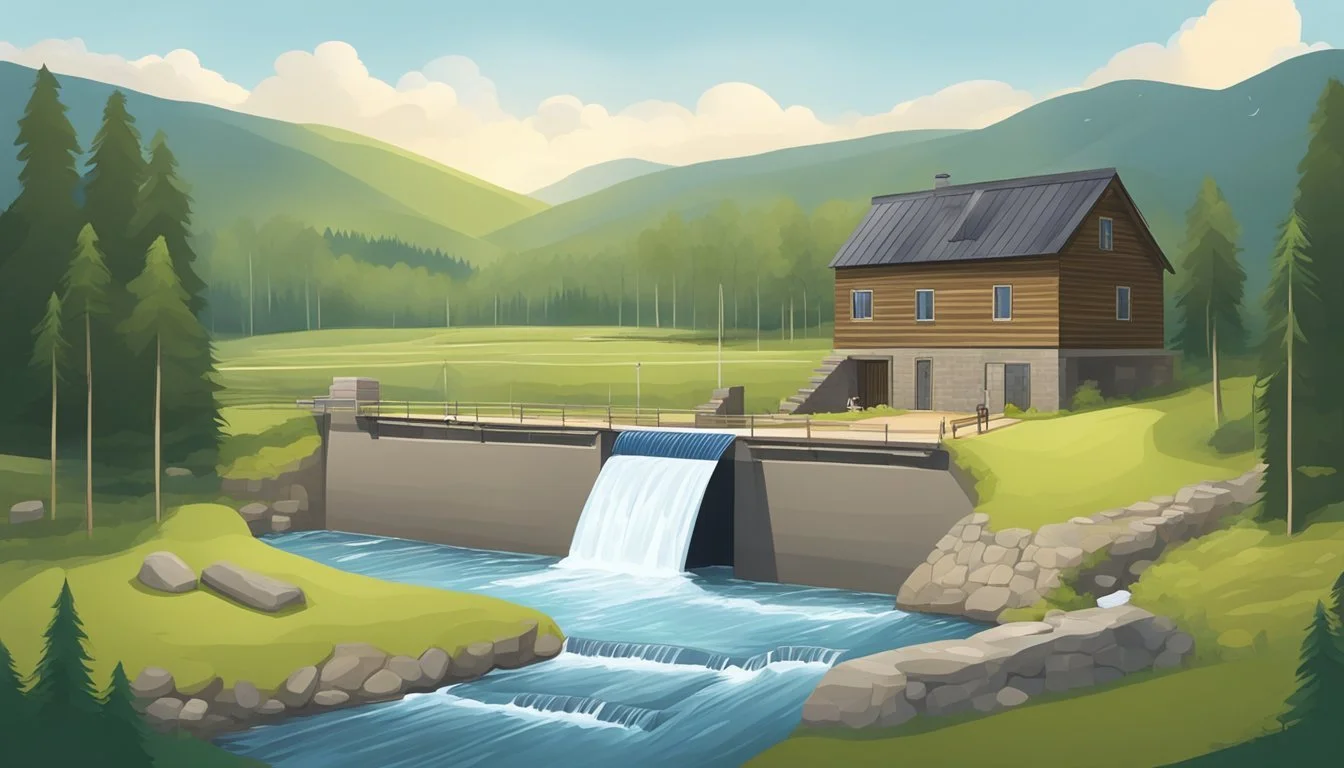Small Scale Hydropower for Homesteaders
Harnessing Renewable Energy Efficiently
Small-scale hydropower is a viable and efficient method for homesteaders to generate electricity. Suitable for properties with access to flowing water, this renewable energy source can provide a reliable power supply. The concept hinges on harnessing the kinetic energy of water, typically through the use of micro-hydro systems, which are designed to be manageable for individual households. These systems, capable of generating 75 to 350 kilowatt hours per month, can significantly offset conventional energy consumption and reduce utility bills.
Homesteaders often find that a micro-hydro system, which can be as simple as water wheels or as complex as turbines, offers a certain self-sufficiency in energy production. A 10-kilowatt system is usually sufficiently robust to power a large home or a small farming operation. The appeal of micro hydropower extends beyond its functionality; water wheels, in particular, can add aesthetic value to a property while contributing to its energy independence.
The installation process and upkeep of small hydropower require thoughtful consideration regarding system placement and water flow management. Unlike solar power, where more panels can mean more electricity, the output of hydropower systems is limited by the volume and flow rate of water available. Consequently, homesteaders must carefully assess their land's water resources and potential environmental impact to ensure a sustainable and efficient energy solution.
Small-Scale Hydro-electric Power Generation Fundamentals
Small-scale hydropower provides a renewable energy source, tapping into the energy of flowing water on a property to generate electricity.
Understanding Hydropower
Hydropower is the process of converting the kinetic energy of moving water into usable electrical power. As a source of renewable energy, it relies on the water cycle, which is driven by the sun, making it a sustainable and reliable way to produce energy.
Generally, these are large-scale and installed as infrastructure for cities that are close to large bodies of moving water. Still, mini hydro systems are gaining popularity in the homestead as the energy efficiency is astounding. A good micro-hydro system can produce electricity year-round unlike solar power solutions
When water flows down a river or stream, it can be harnessed by a hydropower system. One critical aspect for homesteaders to consider is the water flow rate on their property since it directly impacts the potential energy output.
Generating Electricity with a Hydro Systems
A typical micro hydropower system comprises various components that work in unison to convert water flow into electricity:
Intake Structure: Often includes a trash rack to block debris, a weir to help manage water flow, and a forebay to stabilize the water before it enters the system.
Penstock: A conduit that channels flowing water to the turbine.
Turbine: Converts the kinetic energy of water into mechanical energy.
Generator: Converts mechanical energy from the turbine into electrical energy.
Regulator: Manages electricity flow to suit the demand and protect the system.
Tailrace: Channels water away from the turbine back to the stream.
Homesteaders can expect these systems to produce up to 100 kilowatts, with many generating between 75 to 350 kilowatt-hours (kWh) per month.
This scale of operation is typically referred to as micro-hydropower and is suitable for homes and small businesses, including farms and ranches. The environmental footprint of a small hydropower system is generally low, making it socially responsible, and the systems can be customized to fit various landscapes and locations.
Site Assessment and Preparation
Before a homesteader can tap into the energy of a stream to produce power, it is crucial to conduct a thorough site assessment and prepare by securing necessary water rights and permits and speak to the Federal Energy Regulatory Commission.
A well-evaluated site ensures the viability of the small hydropower project and compliance with legal and environmental regulations.
Evaluating Site Potential
A homesteader must first assess the potential of a site for hydroelectric power generation. This involves calculating the flow rate of the stream and the head, which is the vertical drop that creates hydroelectric potential. It is imperative to utilize accurate methods for measuring these key factors, as they determine the feasibility and the scale of the hydropower system. Key steps in assessing a site include:
Flow Measurement: Use a flow meter or a simple float method to estimate the volume of water flowing per second.
Head Measurement: Determine the vertical distance water will travel from intake to turbine, using tools such as altimeters or surveying equipment.
Securing Water Rights and Permits
After assessing the site potential, homesteaders must navigate the process of securing water rights and obtaining the necessary permits. This is a complex legal area, and specific requirements vary widely by region, but two things remain constant:
Water Rights: Verify that they have the legal authority to divert water from the stream and use it for power generation.
Permits: Apply for permits by regional and national guidelines. This often includes environmental impact assessments and public consultation processes.
Homesteaders should prepare detailed applications that align with the scope of their project, ensuring all environmental considerations and impacts are addressed. Proper documentation and adherence to regulatory frameworks are critical to avoid legal challenges or project shutdowns.
Design and Components of a Micro-hydro System
Microhydropower systems are a feasible sustainable energy solution for homesteaders. Focusing on the proper assessment of head and flow, and the selection of appropriate hardware such as the turbine, generator, and a quality penstock is vital for the efficient design of these systems.
Determining Head and Flow
The head refers to the vertical distance that the water falls in. The flow rate measures the volume of water passing a point over a given period, crucial for calculating the potential energy. Homesteaders must accurately assess both to estimate the system's power output. They typically measure flow in gallons per minute or cubic feet per minute and express head in feet or meters.
Head Measurement: Height difference between water source and turbine.
Flow Rate Measurement: Typically in gallons per minute (GPM) or cubic feet per minute (CFM).
Selection of Turbine and Generator
The turbine converts water flow into rotational energy, which the generator uses to produce electricity. The choice depends on the head and flow measurements:
High Head: Pelton wheel turbines are optimal.
Low Head: Francis or Kaplan turbines are better suited.
Generator: Must match the turbine's energy output for efficiency.
Turbine Type Preferred Head Efficiency Factor Pelton Wheel High Best in class for high head Francis Medium Good for a wide range of conditions Kaplan Low Designed for lower head and higher flow
Designing the Penstock
The penstock is the pipe that delivers water from the source to the turbine. A properly designed penstock minimizes energy losses and withstands high pressure:
Material: Usually steel or PVC, chosen for durability and pressure capacity.
Diameter & Thickness: Depends on flow rate and head; larger diameters for high flow systems, and thicker walls for high head systems to handle the pressure.
Ensuring the integrity of the penstock's design is crucial to the overall efficiency and longevity of the micro hydro system. It's the critical vessel for water conveyance, determining the potential energy deliverable to the turbine.
Installation Process
Installing a small-scale hydropower system involves critical steps to ensure the system generates electricity efficiently. Homesteaders need to focus on building a strong, durable powerhouse and properly installing the penstock and turbine.
Building the Powerhouse
The powerhouse is the heart of a small hydropower system, housing the generator and electrical components. It must be constructed on a solid foundation, often made of concrete, to withstand the forces of running water and the operational vibrations of the machinery.
Key considerations for the powerhouse include:
Location: It should be close to the water source to minimize energy loss and protect from flooding.
Size: Adequate to accommodate all necessary equipment including the generator, inverter, and controls.
Penstock and Turbine Installation
The penstock is a crucial conduit that channels water from the source to the turbine. It must be properly sized and strategically placed to maximize water pressure and flow, which directly affects the system's electricity output.
For penstock and turbine installation:
Penstock:
Material: Typically made of PVC, steel, or HDPE, offering durability and reduced friction loss.
Angle: Align at the steepest practical angle to increase water pressure.
Turbine:
Must be correctly matched with the water flow and head to efficiently convert hydraulic energy into mechanical energy.
Should be securely mounted and aligned with the generator for optimal energy conversion.
Homesteaders should ensure all connections are watertight and the system is thoroughly inspected before initiating operations.
Electrical Power Distribution and Management
Efficient energy distribution and management are critical for the successful operation of small-scale hydro-power systems. These systems not only generate electricity but also require precise mechanisms to ensure this energy is effectively delivered and utilized within a homestead.
Wiring and Connection to Home
One begins energy distribution by safely connecting the micro-hydro-power system to the home through a network of wires. This requires:
Proper gauge wiring: To handle the electrical load without overheating.
Circuit protection: Circuit breakers and fuses are essential to protect the system from overloads or short circuits.
Energy Storage Solutions
To consistently produce electricity, especially when water flow is variable, one must consider energy storage:
Batteries: Essential for storing excess electricity, typically grouped into battery banks.
Capacity: Must be sized according to the expected energy needs and the production capacity of the micro hydro-power system.
The aforementioned storage systems allow a homestead to maintain a reliable renewable energy supply, mitigating issues related to the intermittent generation of electricity from hydropower.
Operation and Maintenance
Efficient operation and maintenance of hydro-power systems are crucial for optimizing energy output and extending the lifespan of the equipment. A consistent routine ensures that components function effectively and energy production remains steady.
Routine Maintenance
Daily Tasks:
Visual Inspections: Operators should carry out daily inspections to check for any observable issues such as leaks, blockages, or mechanical wear.
Monitoring Output: Daily checks on electricity output help ensure the system is producing power at expected efficiency levels.
Monthly Tasks:
Lubrication: Regular lubrication of moving parts prevents wear and tear.
Debris Clearance: Clearing debris from intakes and screens maintains water flow and protects equipment.
Bolt Tightening: Checking and tightening bolts prevent mechanical failures due to vibrations.
Annual Tasks:
System Calibration: Annual recalibration of system controls ensures optimal performance.
Detailed Inspection: A thorough inspection of the turbine, generator, and electrical components identifies issues that might not be evident during daily checks.
Troubleshooting Common Issues
Reduced Output:
Cause: Partial blockage in the water intake or debris in the turbine.
Solution: Regular cleaning and removal of obstructions to restore water flow.
Mechanical Failures:
Cause: Lack of maintenance, overuse, or age-induced wear.
Solution: Replace worn components, and adhere strictly to maintenance schedules.
Electronic Issues:
Cause: Voltage fluctuations or short circuits.
Solution: Systematic electrical testing and replacing faulty wiring or components.
Through attentive operation and structured maintenance, hydro-power can provide reliable energy for homesteaders, enhancing the longevity and efficiency of their renewable power source.
Economic and Environmental Considerations
When homesteaders evaluate the viability of a micro-hydro system, they must consider the balance between economic feasibility and environmental stewardship. Cost analysis and environmental impact are intertwined, each playing a crucial role in the decision-making process.
Cost Analysis and Budgeting
Initial Investment: The upfront cost of equipment, installation, and potential regulatory compliance varies, with systems generating 75 to 350 kilowatt hours per month which is typical for small homesteads. Initial site survey, equipment selection, and installation form the bulk of this investment.
Return on Investment (ROI): Small-scale hydropower projects are lauded for their short ROI period due to fuel savings and the potential for incentives or subsidies.
Ongoing Expenses: Maintenance costs are relatively low, which, when combined with the long asset life, contribute to the overall affordability of the system.
Understanding Environmental Impact
Clean Energy Production: Hydro-power is a source of renewable energy that reduces reliance on fossil fuels and contributes to the fight against climate change by offering a cleaner way to generate electricity.
Ecosystem Considerations: It is imperative to minimize ecological disruption, including preserving local waterways and aquatic habitats.
Sustainability: These systems have a minor impact on their surroundings and can be installed to preserve environmental integrity.
By analyzing both the economic and environmental factors, homesteaders can make informed decisions on small-scale hydropower installations that are both economically sensible and environmentally sensitive.
Renewable Energy Advancements and Future Outlook
Small-scale hydropower has seen significant enhancements in efficiency and environmental impact. Homesteaders should be aware that these advancements are key to the practicality and future sustainability of their renewable energy sources.
Innovations in Hydroelectric Technology
Recent innovations have greatly improved the efficiency and feasibility of small-scale hydroelectric systems. These systems now often employ run-of-river technology, which does not require a dam and has a minimal ecological footprint.
Additionally, the integration of High-Compacting Machinery (HCM) has allowed for more efficient energy output in smaller waterways that were previously unsuitable for hydro-power. Manufacturers have also made strides in creating modular and scalable turbines, which can be customized to the specific needs of a homestead's available water resources.
Key Innovations:
Run-of-river installations
High-Compacting Machinery (HCM)
Modular, scalable turbines
The Future of Renewable Energy
The future landscape of renewable energy, and specifically small-scale hydro-power, is poised for growth. It is expected to contribute significantly to the overall mix of green energy solutions by harnessing untapped potential globally.
Projections suggest that by 2023, an additional 125 gigawatts of hydropower capacity could be realized.
In the long term, advancements in small-scale hydro could lead to substantial reductions in greenhouse gas emissions while conserving trillions of gallons of water. Therefore, for homesteaders evaluating their renewable energy options, small-scale hydropower represents a green, forward-looking choice.
Future Projections:
Additional 125 gigawatts by 2023
Reduction in greenhouse gas emissions
Significant water conservation
Resources for Homesteaders
Homesteaders seeking to harness the power of small-scale hydropower can access a wealth of resources to educate themselves and obtain the necessary equipment. Detailed educational materials offer guidance on system implementation, while suppliers provide comprehensive kits simplifying installation.
Educational Materials
Homesteaders should seek out authoritative and comprehensive educational materials that cover the fundamentals of mini hydro systems. They need information on assessing water flow, calculating the 'head' or drop, and understanding the components of a hydro-power setup.
Resources may include online tutorials, books, and government resources such as the Department of Energy, which provides insights into the simplicity and consistency of renewable micro-hydropower systems.
Suppliers and Installation Kits
For the installation process, homesteaders should consider suppliers that specialize in home hydro power kits. These micro hydro kits typically contain turbines, generators, controllers, and pipes—everything needed to convert flowing water on a property into electricity.
t's essential to select a hydro system kit that matches the specific characteristics of the water source, including flow rate and head height.
Basic Hydroelectric Kit Components:
Turbine
Generator
Controller
Piping and wiring
When selecting a supplier, they should look for those with a track record of quality and customer support to ensure successful setup and long-term operation.
Case Studies and Success Stories
Exploring real-life applications of micro-hydro systems for electrical power showcases their potential to provide sustainable renewable energy solutions for homesteaders. This section examines both individual experiences and broader implementations of these systems.
Homesteader Hydro-Power Experiences
Homesteaders across various regions have integrated micro-hydro systems to harness the power of local water sources and produce energy.
For instance, one homeowner successfully installed a home-scale kit utilizing the consistent flow from a nearby stream, achieving a symbiotic relationship with the natural water cycle. They report this system covers a substantial portion of their electricity needs, reducing reliance on the grid.
Employing micro-hydro systems supplemented with biogas contributed an impressive 30-40% was seen in another rural estate's decision. This energy primarily powers essential services for local communities including schools and factories.
Microhydro Systems in Action
Small-Scale Success: A small hydropower project, with a capacity under 10 MW, highlights the effectiveness of these systems in a community setting.
They generate power and redirect it back into the local infrastructure, contributing significantly to rural electrification and reducing fossil fuel dependency.
Community Empowerment: Community-scale micro-hydro (CSM) projects stand out in several regions as beacons of good practice. These decentralized energy solutions not only foster sustainable development but also bolster the global energy transition towards renewables.
Case studies show the ability to produce electricity via CSM can fulfill energy needs whilst being environmentally conscious.









